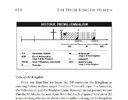Jimmy the Greek
Puritan Board Senior
If Historic Premills see no time delay between the rapture and the parousia, how do unbelievers get into their Millennium?
Follow along with the video below to see how to install our site as a web app on your home screen.
Note: This feature may not be available in some browsers.
Historic premils argue that believers rise to meet the Lord in the air and return to the planet to rule with him. The term used for meet the Lord in the air is the one used in Acts for the delegation going out to meet the Apostle Paul and accompany him back to Rome.
The question I have has to do with the mixing of resurrected bodies and natural bodies during the literal millennium envisioned by historic premils. Am I to believe that I will be living in my resurrection body next door to a person who still gets married, drives to work, procreates, raises his family, gets colds, takes vacations to Yosemite, contracts cancer, and dies?
Wow! Do I get to know a man, his son, grandson, great grandson, great great grandson, etc. over the course of 1,000 years?
2. Both historic and dispensational premills see the millennium populated to some extent with unregenerate natural people, who participate in the final rebellion at the end of the 1000 years.
3. The dispensationalist explains the natural people in the millennium as the offspring of those who were saved in the 7 years between the rapture and the parousia.
4. But the historic premill has no such luxury in his explanation since the rapture and parousia are concurrent. Thus my question. How do unregenerate natural people get into the historic premills millennium.
5. This is aside from the troubling thought that Dennis raised: of co-existence of glorified saints and unregenerate in the millennium. Not to mention the fact that all premills see evil and death continuing after the second coming.
Unbelievers cease their rebellion against Jesus King

Jesus returns, sets up his kingdom, believers are transformed. Unbelievers cease their rebellion against Jesus King, but we have no reason on the premil scheme on why they must be born against or immediately go to hades.
Jesus returns, sets up his kingdom, believers are transformed. Unbelievers cease their rebellion against Jesus King, but we have no reason on the premil scheme on why they must be born against or immediately go to hades.
But my point is that there is every reason that unbelievers "immediately go to hades" at the return of Christ. For which see Matt. 13:41-42, 24:39, and Paul in 2 Thess 1:8-10:
" ... Those who do not know God and do not obey the Gospel of our Lord Jesus Christ ... will be punished with everlasting destruction and shut out from the presence of the Lord and from the majesty of his power on the day he comes to be ... marveled at among all those who have believed"
Jesus returns, sets up his kingdom, believers are transformed. Unbelievers cease their rebellion against Jesus King, but we have no reason on the premil scheme on why they must be born against or immediately go to hades.
But my point is that there is every reason that unbelievers "immediately go to hades" at the return of Christ. For which see Matt. 13:41-42, 24:39, and Paul in 2 Thess 1:8-10:
" ... Those who do not know God and do not obey the Gospel of our Lord Jesus Christ ... will be punished with everlasting destruction and shut out from the presence of the Lord and from the majesty of his power on the day he comes to be ... marveled at among all those who have believed"
Sure. I understand that. The premillennial is just giving due weight to Isaiah 24-27 and Revelation 20 (and possible 1 Cor. 15:20-28).
Jacob, with respect to your saying, “And to be clear, I am not arguing for the truth of premillennialism exegetically. I am merely trying to show logical coherence”: Apart from sound exegesis there can be no “logical coherence” in the discerning of Scripture. And Scripture is truth (John 17:17).
What weight does Isaiah 24-27 have in support of the premil view?
Can you show where in Isaiah 24-27 you would go to support your views?
From what I have heard, Ladd never explained the existence of unregenerate humans in his millennial view, he just assumed it was true. I am not arguing for or against Historic Premill (although I am Amill). I am just asking how they logically get unregenerate people into thier millennium. Still havent heard an answer. But alas, Jacob is the only one answering for them here on the PB and I am reluctant to belabor the point. I have spent some time searching online to no avail.
I’m sorry but your approach to defending the Historic Premil is sort of like an ER doctor with a patient, running around giving him all sorts of shots and treatments, combing the hair of the patient, and tidying his gown, but the patient appears to be a corpse and the doc just keeps repeating “There are no logical contradictions in my efforts!”
Unbelievers cease their rebellion against Jesus King
Maybe this could be differently phrased. I say this because unbelievers are a rebellion against King Jesus. That is what unbelief toward God is: rebellion against God.
only God's written Word is logically consistent
Unbelievers cease their rebellion against Jesus King,
I say this because unbelievers are a rebellion against King Jesus. That is what unbelief toward God is: rebellion against God.